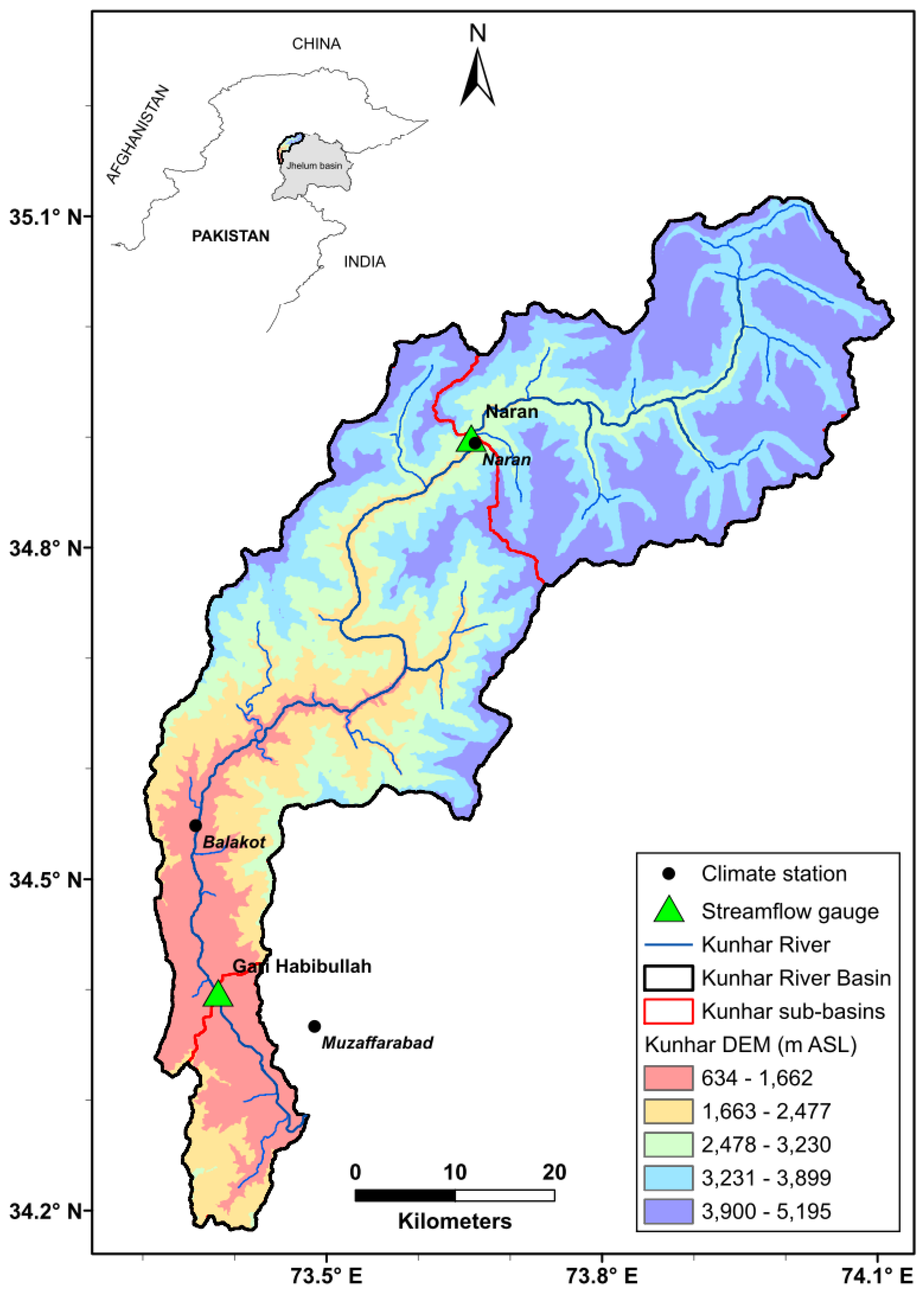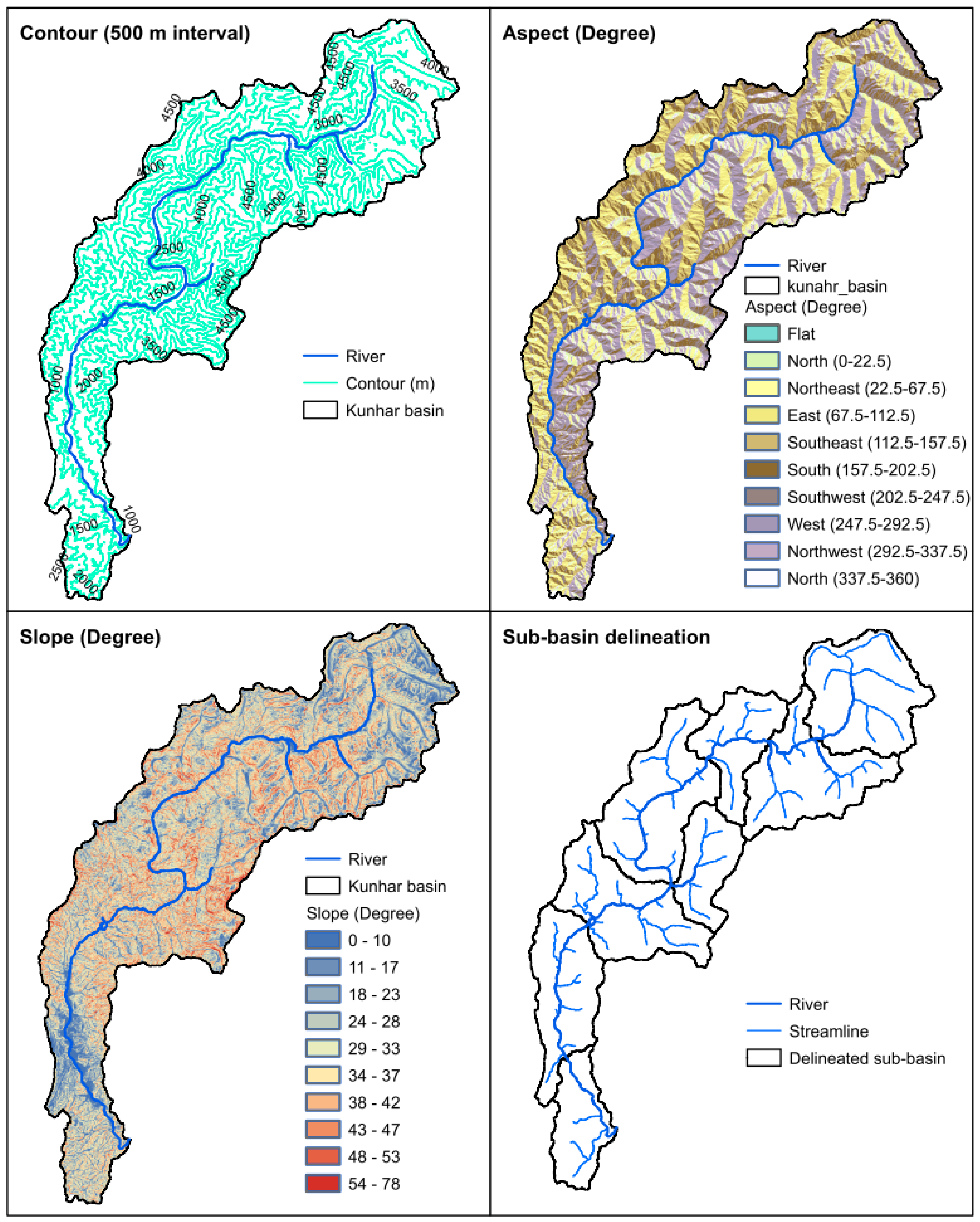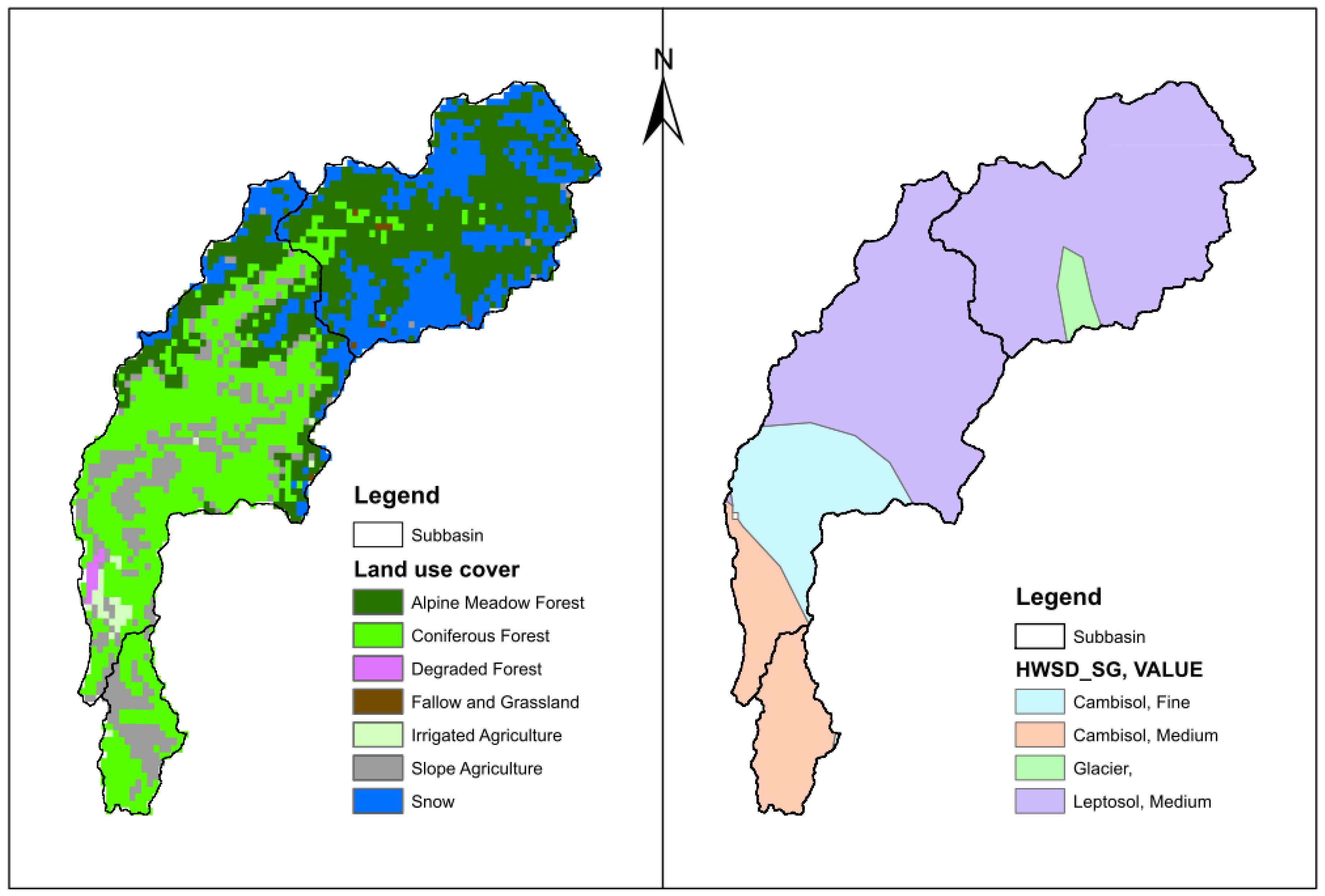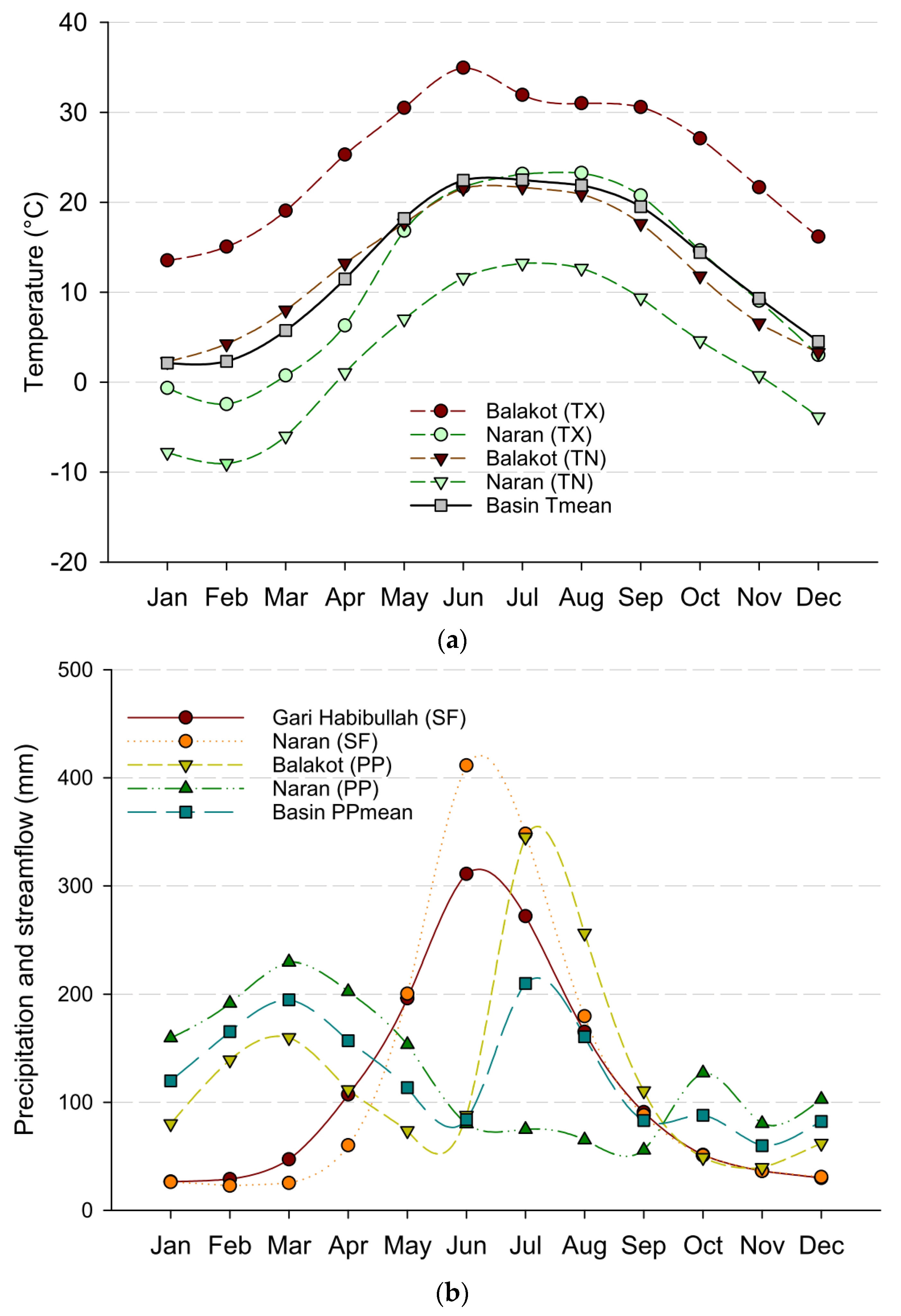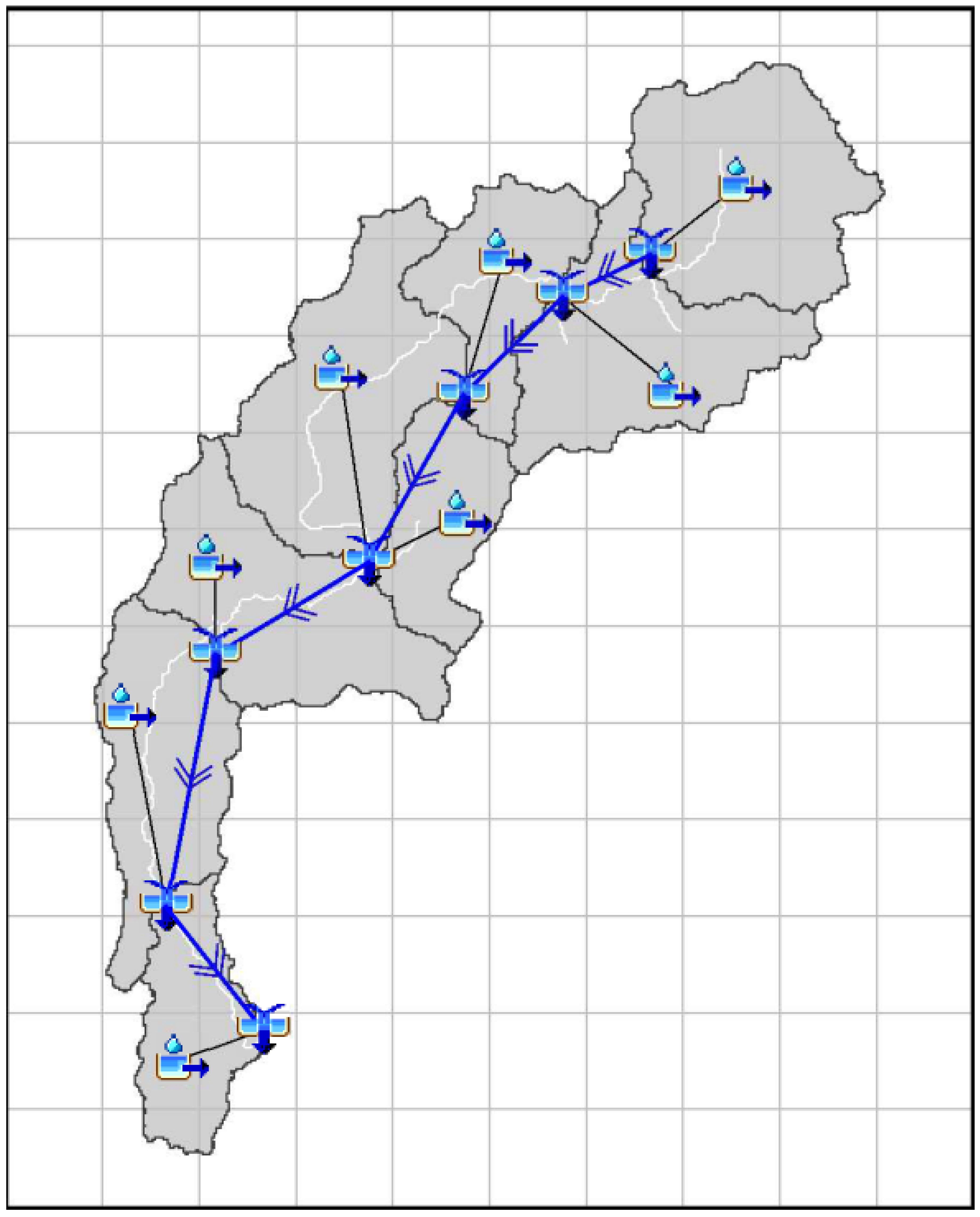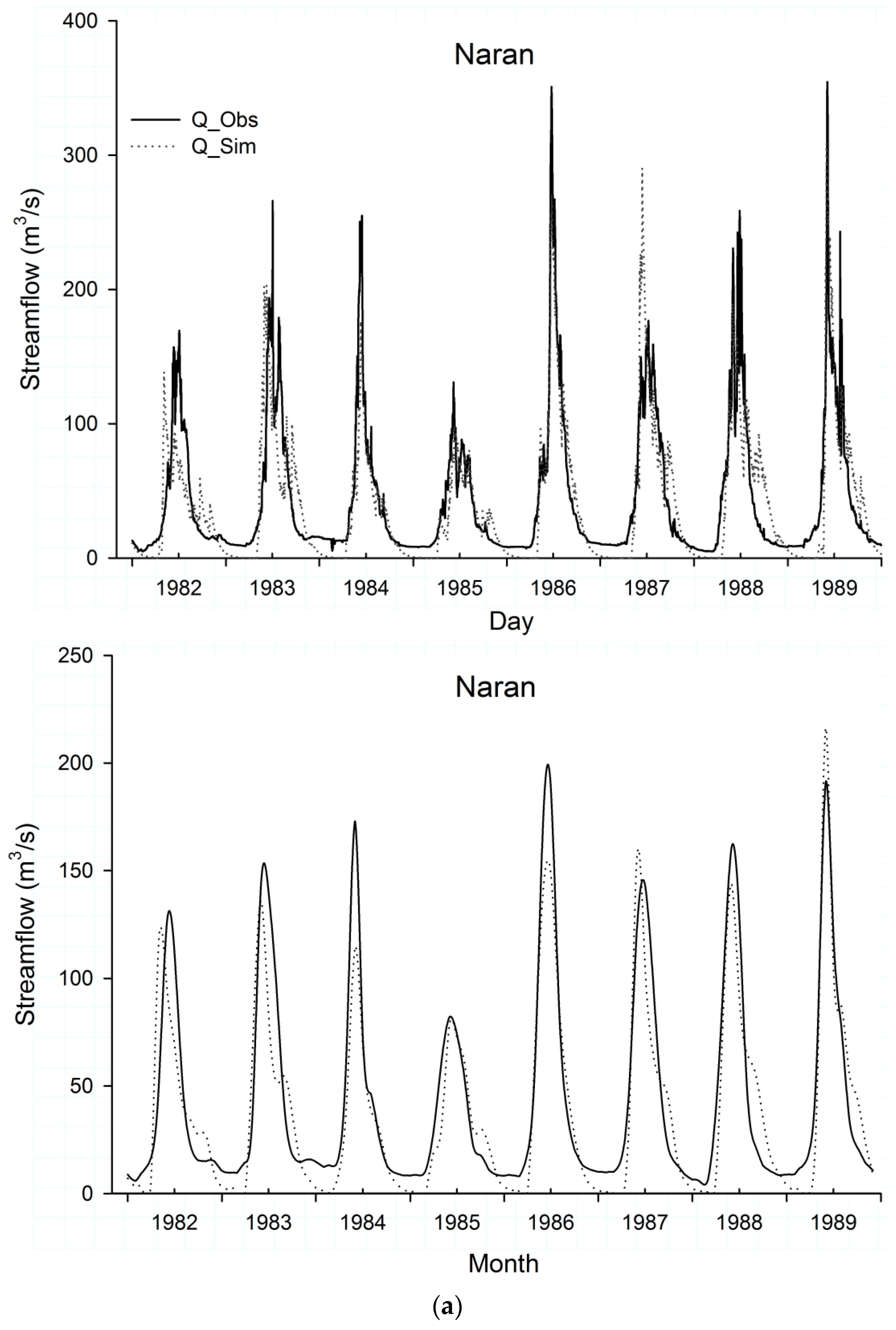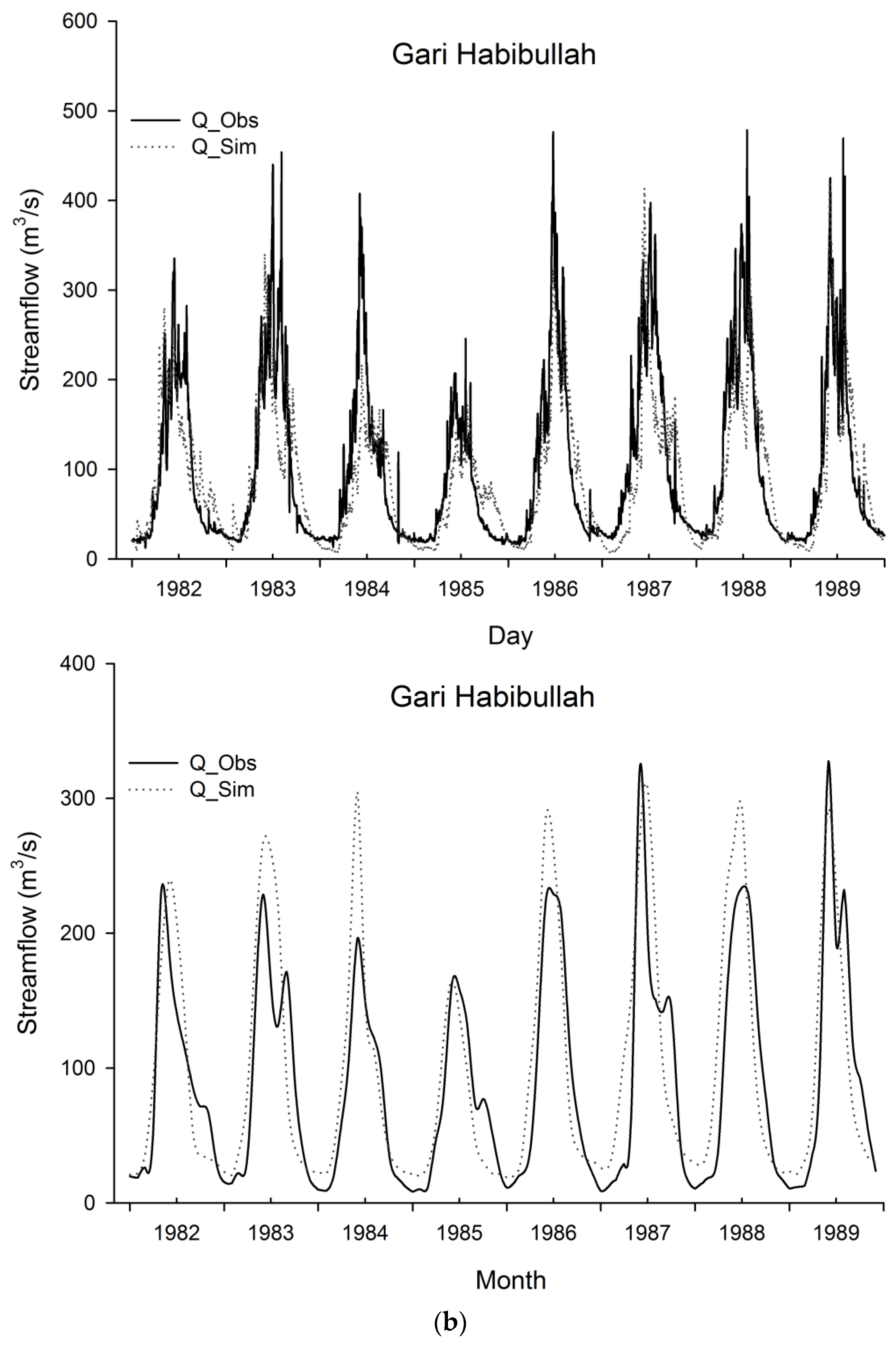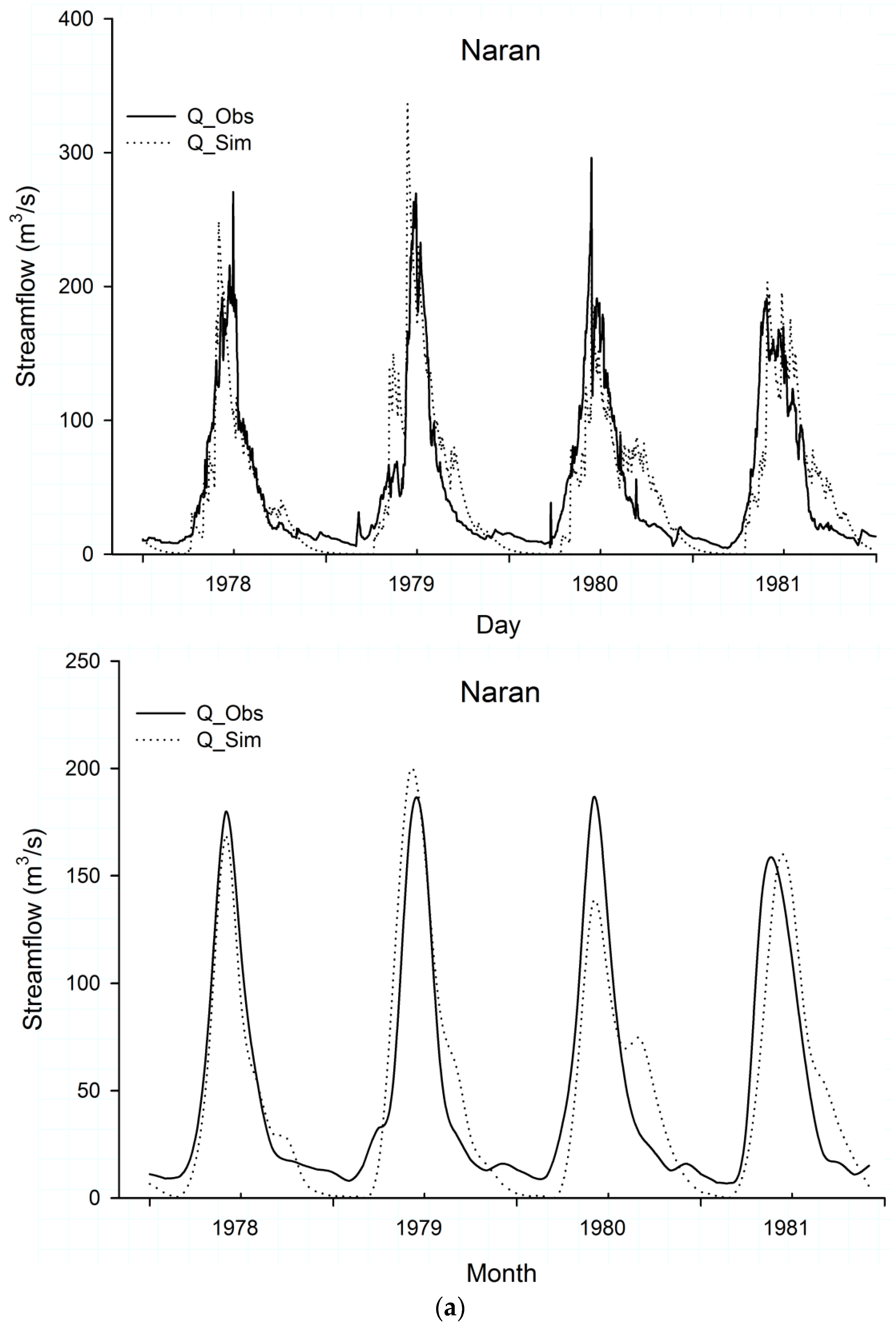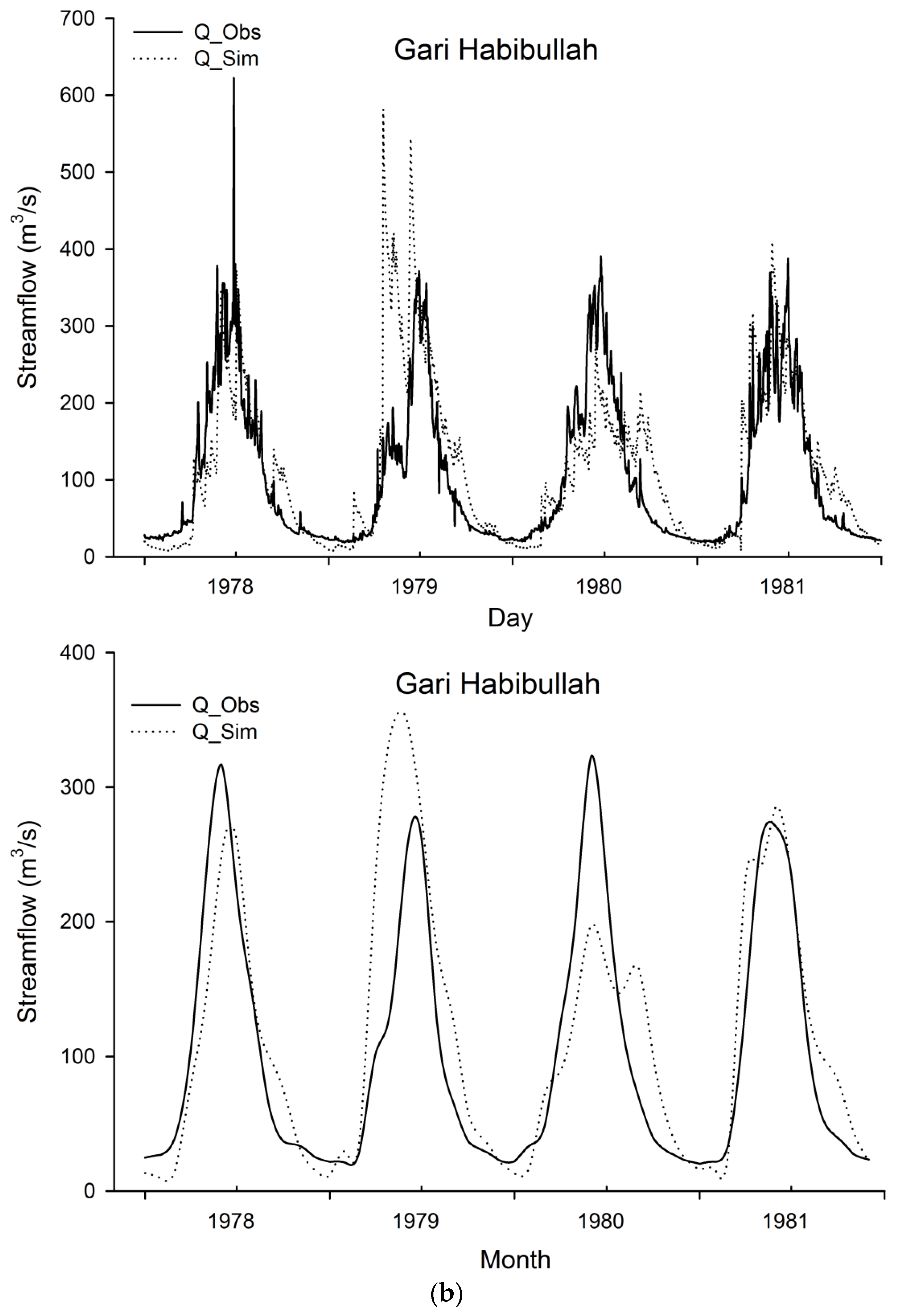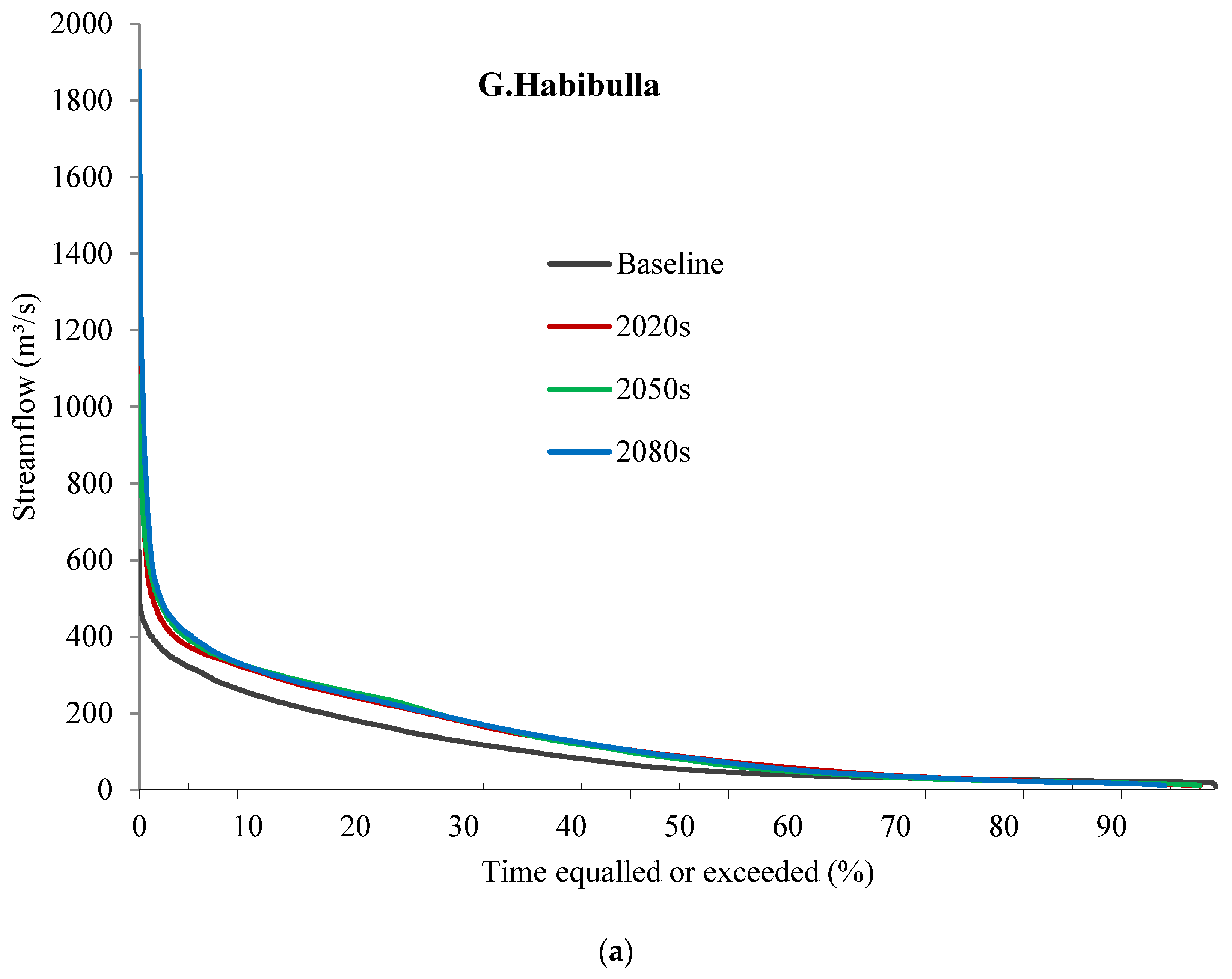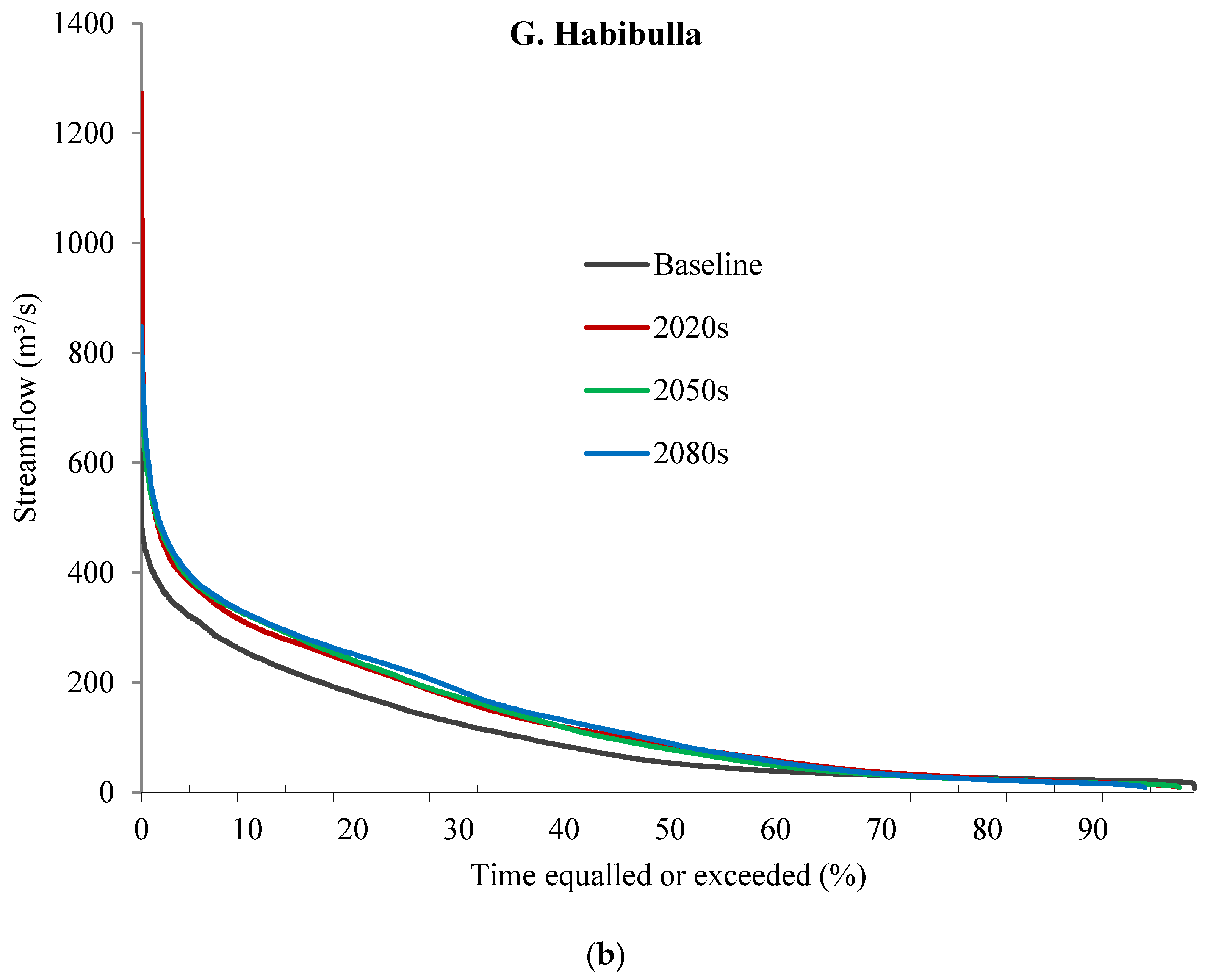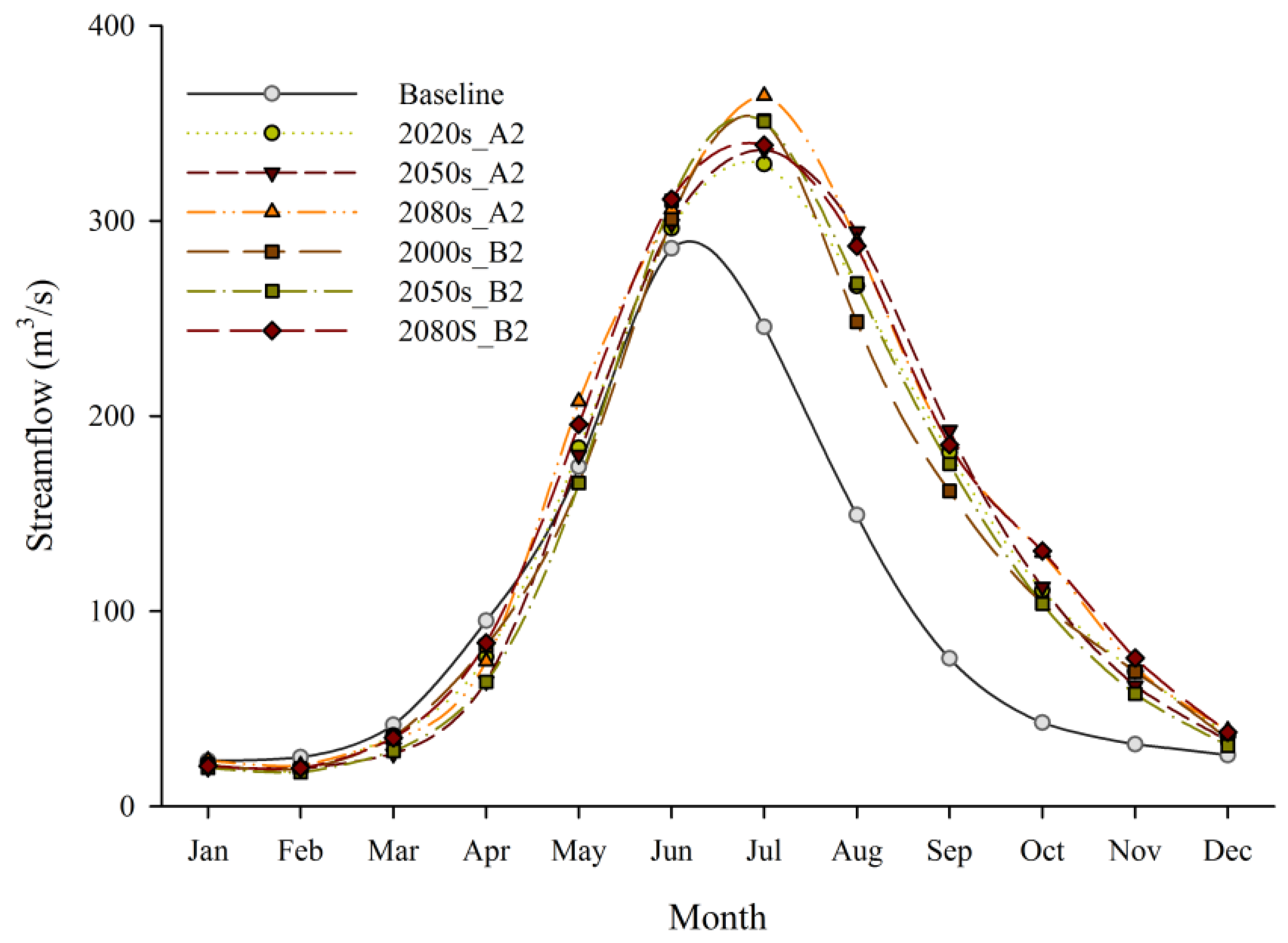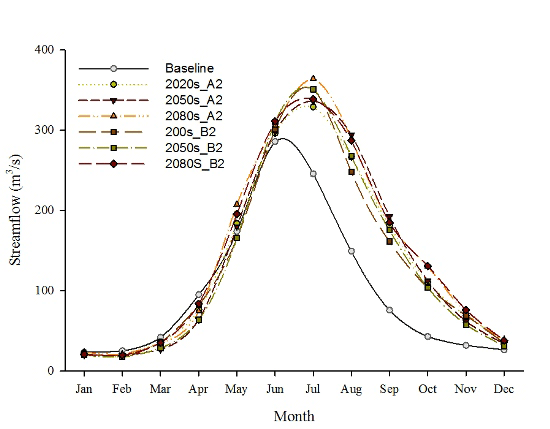1. Introduction
The concentration of greenhouse gases (GHGs) has dramatically increased during the last few decades because of anthropogenic forces such as burning of fossil fuels and biomass, land use changes, rapid industrialization, and deforestation. This increased GHGs concentration has resulted in global warming and a global energy imbalance [
1,
2]. According to the Fifth Assessment Report of the Intergovernmental Panel on Climate Change (IPCC-AR5), the global average temperature has increased by 0.85 °C (0.65 °C–1.06 °C) over the period of 1800–2012, relative to 1961–1990 [
3], and 0.74 °C ± 18 °C has been detected during the last hundred years (1906–2005) [
4]. There is a very high likelihood of this trend in global warming to only exacerbate. The global average temperature is projected to increase by 1.7 °C–4.8 °C in 2081–2100 (relative to 1986–2005) under different Representative Concentration Pathways (RCPs).
The projected increase in global warming is likely to intensify the hydrological cycle of the world, and hence, disturb the existing hydrological system. As a consequence of global warming, hydrological systems are likely to experience changes in the average availability of water, as well as changes in extreme events such as increase in precipitation intensity, frequency, and/or amount of heavy precipitation [
5,
6,
7]. For example, the average annual precipitation is likely to increase in the high latitudes and the equatorial Pacific Ocean by the end of the 21st century under RCP8.5. However, in several mid-latitude areas and subtropical dry regions, mean precipitation is likely to decrease. The areas of the globe with increasing precipitation are much more than those with decreasing precipitation [
3]. This disturbance in a hydrological system can pose problems for public health, industrial and municipal water demand, water energy exploitation, and the ecosystem. However, as stated above, the impact of climate change on hydrological systems may vary from region to region [
2,
3,
5,
8].
Hydrological systems are of great importance as they greatly affect the environmental and economic development of a region and are highly complex because they comprise the atmosphere, cryosphere, hydrosphere, biosphere, and geosphere. The hydrological cycle of a basin (catchment) is mainly influenced by the physical characteristics of the basin, climatic conditions in the basin, and human activities. Most studies on climate change have focused on temperature, precipitation, and evaporation [
9] since these are considered to be the key indicative factors of climate change and variability in a river basin [
10]. There is an increasing consensus that changing trends in climatic variables, especially temperature and precipitation, can change the hydrological and ecological conditions of a river basin [
11,
12]. Given all these conditions, it is of great importance to assess the possible impacts of climate change on the water resources of a region, which can help in the proper utilization and management of these water resources.
The economy of Pakistan relies greatly on agriculture, which is heavily dependent on the Indus River Irrigation System. Water issues in Pakistan are crucial challenges for the policymakers and managers of water resources in the country [
13]. Today, Pakistan is one of the most water-stressed countries in the world as water availability in the country has reduced from about 5000 m
3 per capita per year in 1952 to 1100 m
3 per capita per year in 2006, which is an alarming situation [
14]. According to the United Nations report, a country with water availability of less than 1000 m
3 per capita per year is considered a water scarce country [
15]. The reduction in water availability has created tensions among different provinces due to the increasingly unequal distribution of water. Climate change and variability are likely to affect water availability for, and magnitude of, irrigation and hydropower production in the country. These changing water conditions are likely to increase the tensions among the provinces, especially at the downstream (Sindh province) [
13]. Therefore, a clear estimation of future water resources under changing climatic conditions is of great importance for the planning, operation, and management of hydrological installations in any watershed in Pakistan.
In the last few years, outputs from General Circulation Models (GCMs)—the most advanced and numerical based coupled models—are fed into hydrological models to explore the impacts of climate change on water resources in various parts of the world in the future. However, these models are coarse in spatial resolution (about 200–500 km) [
16] and might not be suitable at the basin level, especially small basins which require very fine spatial resolution [
17,
18]. To bridge GCM resolution and basin scales, downscaling—dynamical and statistical—techniques have been developed. In dynamical downscaling, a high-resolution numerical based Regional Climate Model (RCM), with a resolution of about 5‒50 km, uses the course outputs of a GCM and provides detailed information or high resolution outputs at the basin level [
2]. On the other hand, Statistical downscaling (SD) methods (
i.e., stochastic weather generator, regression, and weather typing) create empirical/statistical relationships between the GCM scale and basin scale variables (e.g., temperature and precipitation). Compared to dynamical downscaling, SD methods are faster and computationally inexpensive, and thus offer approaches that have been rapidly adopted by a wider community of scientists [
17]. For the present study, downscaled data (maximum temperature, minimum temperature, and precipitation) was obtained from [
1]. They used a Statistical Downscaling Model (SDSM), a combination of multiple linear regression and a stochastic weather generator, to downscale temperature and precipitation over the period of 2011–2099 under A2 and B2 scenarios of HadCM3, a global climate model.
Different studies such as Akhtar
et al. [
13], Ahmad
et al. [
19], Shrestha
et al. [
20], and Bocchiola
et al. [
21] have assessed the impacts of climate change on the water resources of Pakistan [
13,
19,
20,
21]. These studies were mostly conducted in the Upper Indus basin using hydrological models such as Snowmelt Runoff model (SRM), Hydrologiska Byråns Vattenbalansavdelning (HBV), Soil and Water Assessment Tool (SWAT), and the WEB-DHM-S model. However, to the best of our knowledge, no studies have been conducted to explore the potential impacts of climate change on the water resources of the Kunhar River basin, which is one of the main tributaries of the transboundary Jhelum River and is located entirely in Pakistan. The Kunhar River originates from the Greater Himalayas and contributes to the Mangla Reservoir after joining the Jhelum River. The Mangla Reservoir’s water is used for irrigation and hydropower production. It is the second largest reservoir of Pakistan. Although HEC-HMS, a well-known hydrological model, has been successfully used for small to large and plains to mountainous areas of the world [
22,
23,
24,
25,
26,
27], almost no studies have been reported in Pakistan that use HEC-HMS for the assessment of climate change impacts on water resources.
Thus, the main objectives of the present study were: (1) the development of HEC-HMS, a hydrological model, in the mountainous Kunhar River basin which is greatly influenced by winter snowfall; and (2) to assess the possible impacts of climate change on the water resources of the Kunhar River basin, located in Pakistan, under A2 and B2 scenarios of HadCM3. Description of the data and the study area are given in
Section 2 and
Section 3 of this paper. A brief introduction of the hydrological model used in the study, and the methods used for the analysis of streamflow, is given in
Section 4.
Section 5 and
Section 6 include the results/discussion and conclusions respectively. This study will be very useful for policies that govern the utilization and management of the water resources of the Kunhar basin, which contributes significantly to the Mangla reservoir, under the effects of climate change.
3. Study Area
The Kunhar River basin is located in the northern side of Pakistan and stretches between 34.2°–35.1° N and 73.3°–74.1° E, as is shown in
Figure 1. The Kunhar drains the southern slope of the Greater Himalayas, located in the Khyber Pakhtunkhwa (KPK) province of Pakistan. It originates from the Lulusar Lake in the Kaghan valley of KPK. It passes through Jalkhand, Bata Kundi, Naran, Kaghan, Kawai, Balakot, and Gari Habibullah and finally joins the Jhelum River at Rara. The Kunhar’s water is rich in algal flora, resulting in a great diversity of the aquatic life it harbors [
34]. It has a drainage area of 2535 km
2, with elevation ranging from 600 to 5000 m (
Figure 1).
The Kunhar is one of the biggest tributaries of the transboundary Jhelum River basin. This is the only main tributary which is entirely situated in Pakistan’s territory and therefore, has great importance from the perspective of hydrological monitoring by the WAPDA of Pakistan. The Kunhar contributes about 11% of the total flow to the Mangla Reservoir constructed in the Jhelum River basin. The Mangla Reservoir is the second largest water storage site in the country. The water stored here is primarily used for irrigating 6 million hectares of land in the country and for generating hydropower. The installed capacity of the Mangla power plant is 1000 MW, and electricity is generated as a byproduct [
1,
35]. Snowmelt from the Kunhar basin contributes about 65% to the total discharge of the Kunhar River and 20%‒40% to the Jhelum River at Manga [
35]. The population in the Kunhar basin is almost entirely rural and their economy is generally agro-pastoral based. The principal occupation of the population is agriculture, although rearing livestock is also practiced in the adjacent mountainous areas. A small portion of the population is involved in trade, local labor, and employment in the bigger cities of the country [
36]. In Pakistan, 93% of the total annual flow is used for agricultural purposes, 5% for industrial use, and 2% for domestic use [
37]. The water of the Kunhar River is mostly used for irrigation, municipal use, power generation, and recreation [
35]. Since no industries are located in the basin, most of the water of the Kunhar Basin (about 98%) is used for agriculture and the rest for domestic use.
The data of other major topographical characteristics such as slope, contours lines, aspects, and delineated sub-basins, which were extracted from DEM, are presented in
Figure 2. This figure shows that the basin has undulating relief ranging from 0° to 78°. The plains along the course of the Kunhar River are located on a gentle slope (0°‒10°). However, most parts of the basin have moderate (>10° and <30°) to steep slopes (>30°).
The basin has a great diversity of vegetation such as temperate coniferous forests, subtropical coniferous forests, alpine meadows, agricultural cover, and snow, as described in
Table 2 and shown in
Figure 3. These varied land covers are reclassified into seven main classes to explore the major land use covers in the basin. Forest, agriculture, and snow cover the maximum area of the basin with about 65%, 14%, and 20% respectively (
Table 2). This information was derived from the land cover data of 1 km resolution in the basin.
Table 2.
Basic characteristics of soil and land use data in the Kunhar River basin.
Table 2.
Basic characteristics of soil and land use data in the Kunhar River basin.
| | HWSD-Soil Group | Area | Texture | Top Soil Fraction | TSGC |
| % | km2 | | Sand (%) | Silt (%) | Clay (%) | Gravel (%) |
| 1 | Cambisol | 14 | 344 | Medium | 42 | 36 | 22 | 9 |
| 2 | Cambisol | 13 | 342 | Fine | 22 | 30 | 48 | 8 |
| 3 | Leptosol | 71 | 1801 | Medium | 43 | 34 | 23 | 26 |
| 4 | Glacier | 2 | 48 | - | 0 | 0 | 0 | 0 |
| | Land use cover | Area | Land Use Cover |
| | Re-classes | % | km2 | Original |
| 1 | Coniferous Forest | 33.1 | 838 | Temperate Conifer/Subtropical Conifer/Tropical Moist Deciduous |
| 2 | Degraded Forest | 0.4 | 11 | Degraded Forest |
| 3 | Fallow and Grassland | 0.3 | 7 | Slope Grasslands/Sparse vegetation (cold)/Gobi/Desert (cold) |
| 4 | Alpine Meadow Forest | 31.8 | 805 | Alpine Meadow |
| 5 | Irrigated Agriculture | 1.0 | 25 | Irrigated Agriculture |
| 6 | Slope Agriculture | 13.0 | 329 | Slope Agriculture |
| 7 | Snow | 20.5 | 521 | Snow |
There are three main groups of soils in the Kunhar River basin, as shown in
Figure 3: 1) cambisol fine, 2) cambisol medium, and 3) leptosol. Cambisol characterizes weak to moderately developed soils and it (both fine and medium varieties) covers 27% of the basin, while leptosol is very shallow soil over hard rock and is unconsolidated and very gravelly material. Leptosol covers around 71% area of the basin. Some glacier patches also exist in the upper part of the basin. The basic information about soil types found in the basin is given in
Table 2. The properties of these soils were derived from the soil data of 1 km resolution in the basin.
The Kunhar basin is located in a humid, subtropical zone. In the present study, hydro-climatic data was processed for the period of 1961–2000 to extract some basic information about the hydro-climatic conditions in the basin. This information is presented in
Figure 4. The average annual temperature in the basin is about 13 °C (2 °C–23 °C). February is the coldest and July is the warmest month here. This was calculated from the data of the Naran and Balakot climate stations available for the period of 1961‒2000. At Balakot, located in the lower part of basin (
Figure 1), TN ranges from 2 °C (January) to 23 °C (July) and TX from 14 °C (January) to 35 °C (June). At Naran, located in the upper part of the basin, TN ranges from −9 °C (February) to 13 °C (July) and TX from −1 °C (February) to 23 °C (July) (
Figure 4a). The Kunhar basin has an annual precipitation of about 1500 mm (
Table 1) with two peaks (
Figure 4b). The first peak occurs in the upper part of the basin in the month of March because of the Western Disturbances (WDs) system in winter. Most parts of Pakistan, and its northwestern parts primarily, obtain precipitation due to WDs. WDs are caused by depressions over Mediterranean regions, resulting in precipitation over central and southwest Asia in the months of December to March [
38,
39]. The second peak happens in the month of July and in the lower parts of the basin due to the summer monsoons, which are the result of the saturated south western winds from the Bay of Bengal and Arabian Sea. It can be concluded that the monsoons do not reach the upper part of the basin, although WDs affect the whole basin. On the other hand, there is only one big streamflow peak, both in the upper (Naran) and lower parts (Gari Habibullah) of the basin, that occurs in the month of July (
Figure 4b). This means the precipitation from December to March (winter) accumulates as snow cover, especially in the upper parts of the basin, and then starts melting after March and lasts till July when it overlaps with monsoon precipitation and results in one big peak. An average flow of about 1350 mm (103 m
3/s) has been measured at Gari Habibullah near the mouth of the basin for the period of 1961‒2000. The same was reported by de-Scally as well [
39].
Figure 4.
Monthly (a) max temperature (TX), min temperature (TN), (b) precipitation (PP), and streamflow (SF) in the Kunhar River basin for the period of 1961–2000.
Figure 4.
Monthly (a) max temperature (TX), min temperature (TN), (b) precipitation (PP), and streamflow (SF) in the Kunhar River basin for the period of 1961–2000.
4. Methodology
4.1. Description of HEC-HMS
The Hydrological Modeling system (HEC-HMS) is a rainfall-runoff simulation software used for a wide range of watersheds from large river basins to small urban areas. The model was formulated by the U.S. Army Corps of Engineers at the Hydrologic Engineering Center (HEC). HEC-HMS comprises different loss techniques such as SCS curve number, initial and constant, Green Ampt, one-layer deficit-constant, Smith Parlange, and five-layer soil moisture accounting. These techniques are used to estimate excess precipitation in fairly simple to very complex infiltration and evapotranspiration environments. This model can be used for both event and continuous modeling.
In order to calculate direct runoff from excess precipitation, seven methods including SCS, Clark, Snyder, and ModClark are available in the system. This model also consists of five base flow methods including recession method, constant monthly method, and linear reservoir method, and six channel routing methods including Muskingum, and modified pulse methods. It also has six kinds of meteorological models like Thiessen and inverse distance methods to analyze meteorological data such as precipitation, evapotranspiration, and snowmelt. The meteorological model extracts the precipitation for each sub-basin in the watershed. However, currently, only two methods (Temperature Index and Gridded Temperature Index) are available to compute runoff from snowfall in this modeling system [
40,
41].
A complete basin model setup for rainfall-runoff processes comprises a basin model, a meteorological model, control specification, and input time series. The basin model describes the physical characteristics of the study region such as the areas of sub-basins and river lengths of a watershed. Each basin model in HEC-HMS consists of a loss method, a transforming method, a base flow method, and a channel routing method [
23]. Control specification is one of the main components of this model’s setup and it controls the simulation period. For example, it controls when the model is to start and stop, and what the time interval for simulation should be. The input time series encompasses precipitation, temperature, evapotranspiration, and observed streamflow
etc., which have a direct link with the basin’s model and the meteorological model. A detailed description of the model’s formulation and its various processes is provided in the User’s Manual and Technical Reference Manual of HEC-HMS [
40] (p. 318 and p.157).
In the present study, the basin model was developed using the deficit and constant loss (DCL) method for calculating excess precipitation, the SCS unit hydrograph for transforming direct runoff, Muskingum for channel routing, and the recession method for base flow. The meteorological model was established using the Thiessen polygon gauge weight method for precipitation calculation, the temperature index method for snowmelt modeling, and the monthly evapotranspiration method. The Thiessen polygons were created and their weights were calculated by HEC-GeoHMs in accordance with the precipitation gauges. The same combination has been used in different studies [
15,
17,
18].
The DCL model computes excess precipitation in a watershed. It is a single layer continuous method used for calculating the changes in soil moisture content. It is similar to the initial and constant loss (ICL) method but this method recovers the initial losses after a long period of no precipitation. This method contains four main parameters: maximum deficit, initial deficit, constant rate, and impervious percentage. These parameters can be initially estimated using soil and land cover data as initial inputs for the model but are finalized only during the calibration process.
The excess precipitation calculated from DCL was transformed into direct surface runoff by the SCS unit hydrograph method. Basin lag is the only parameter of the SCS method, and it needs to be determined during calibration. It can also be estimated as an initial value for calibration by multiplying the time of concentration by 0.6. In this study, the recession method was used to calculate the base flow which contributes to the total flow from the watershed. Three parameters—initial discharge, recession constant, and threshold—were determined during calibration.
To transfer the total flow from one point to other, the Muskingum method was used. This method is a simple mass conservation scheme for routing flow through channels. There are two main parameters for this method: travel time (K), and the Muskingum coefficient (X). The Muskingum coefficient ranges between 0 and 0.5.
The Thiessen polygon method was used to assign weights to each gauge in the watershed during the development of the meteorological model. For snowmelt modeling, different elevation bands were used for each sub-basin in the temperature index method (TIM). TIM is an extension of the degree-day technique to calculate flow from snowpack. In the degree-day approach, a fixed amount of snowmelt is assigned for each degree above freezing point. This method is a conceptual representation of the cold energy stored in the snowpack. This also takes care of past conditions and some other climatic factors during the calculation of snowmelt. Different parameters such as base temperature, wet melt rate, rain rate limit, melt rate pattern, lapse rate, and antecedent temperature index are required for this method [
32]. A lapse rate of −7.0 °/km was calculated for the study area and kept constant for the entire Kunhar River basin. The FAO Penman-Monteith method—recommended as the standard method for computing potential evapotranspiration [
24]—was carried out to calculate the potential evapotranspiration in the basin. A schemetic diagram for the setup of HEC-HMS in the Kunhar River basin is shown in
Figure 5.
Figure 5.
Schemetic diagram for the setup of HEC-HMS hydrological modeling system.
Figure 5.
Schemetic diagram for the setup of HEC-HMS hydrological modeling system.
4.2. The Model’s Calibration and Validation
The calibration of a model is a process in which the model’s parameters are adjusted in such a way that the simulated flow captures the variations of the observed flow [
25]. In this study, a split sample method was used for calibration and validation. In this method, the calibration period does not overlap with the validation period. A data period of eight years, from 1982 to 1989, was chosen as the calibration period and the period from 1978 to 1981 for validation because these periods had minimum missing values of both precipitation and streamflow. The physical properties—land use cover and soil properties—of the watershed were considered as constant during the simulation period.
Nelder Mead and Univariate Gradient are the two main algorithms to optimize the objective function. There are seven different kinds of objective functions in HEC-HMS. In this study, the sum of the squared residual was chosen and was minimized using the Nelder-Mead algorithm to explore the optimized model parameters in order to get the best results of the simulation. The simulated flows were compared with the observed flow using the coefficient of determination (
R2), percent deviation (
D), and Nash-Sutcliffe efficiency (
E). The
R2 values indicate how well the variations in the observed data are captured by the simulated data,
D describes the mean percent deviation between observed and simulated flow, and
E shows how well the observed plot fits with the simulated plot [
22]. For more illustrative purposes, the simulated data was also compared with observed data graphically to explore how well the low and high observed flows were captured by simulated flow. In the present study, the model was calibrated and validated at both Naran and Gari Habibullah gauging stations.
The model’s performance parameters—
R2,
D, and
E—were calculated using the following equations:
Qobs and
Qsim are observed and simulated values respectively. If the value of
R2 is close to 1, it indicates a good correlation between simulated and observed flows. The correlation is considered optimum if
R2 is exactly equal to 1 [
22].
The value of
D should ideally be close to 0%. Positive and negative values are respectively indicators of over- and under-estimation by the model [
22].
The value of
E lies between 0 and 1. A positive value close to 1 implies good calibration while a negative value close to 0 is not acceptable. If the value of
E is greater than 0.75, then the results are considered to be good, and if it is between 0.36 and 0.75, the results are satisfactory [
41].
4.3. Projected Changes in Streamflow
After successful calibration and validation, the downscaled daily time series (A2 and B2) of precipitation and temperature for the period of 2011 to 2099 were used as input for HEC-HMS to simulate daily flow data at both gauges (Naran and Gari Habibullah). The physical characteristics of the Jhelum basin were kept constant throughout the simulation period. However, it cannot be ignored that these characteristics do vary with time. The simulated data were divided into three periods: the 2020s (2011–2040), the 2050s (2041–2070), and the 2080s (2071–2099) and all three were compared with the baseline period (1961–1990) to assess changes in flow in the future. Different indicators such as mean flow, low flow, median flow, high flow, flow duration curves, temporal shift in peaks, and temporal shifts in center-of-volume dates were calculated for the three periods and the results were compared to the baseline period’s data so as to explore the impact of climate change on the streamflow in the basin.
When analyzing streamflow to construct an installation such as a reservoir and headwork on a river, two questions are frequently asked: (1) how often will the streamflow occur in the future? and (2) what will be the magnitude of the streamflow? Flow duration curves are the main tools to deal with these two questions. These curves present the percentage of times that the flow in a stream is likely to exceed or be equal to a specified value of the flow. These curves can be applied in different kinds of studies such as hydropower management, reservoir sedimentation, water quality management, and low and high flow studies [
42]. The following equation is used to construct the flow duration curves:
P or the probability of flow is equal to or exceeds a specified value (% of time), M is the rank of events, and N is the number of events in a specified period of time.
In the present study, the daily time series were used to construct the flow duration curves for the base period (1961–1990) and for the three future periods: the 2020s, 2050s, and 2080s.
6. Conclusions
Pakistan is one of the most water-stressed countries in the world and its water resources are greatly vulnerable to changing climate. In the present study, the possible impacts of climate change on the water resources of the Kunhar River basin, Pakistan, were assessed under A2 and B2 scenarios of HadCM3. The Kunhar River originates in the Greater Himalayas and is one of the main tributaries of the transboundary Jhelum River. It is located entirely in Pakistan and contributes to the Mangla Reservoir after joining the Jhelum River.
The HEC-HMS hydrological model was used to simulate streamflow in the basin for the future. The model was calibrated and validated for the periods of 1982–1989 and 1978–1981 respectively, at two hydrometric stations (Naran and Gari Habibullah). Three indicators (
i.e., Nash Efficiency, coefficient of determination, and percentage deviation), and graphical representations of differences between observed and simulated data were used to check the performance of the model. Downscaled temperature and precipitation data for the period of 2011–2099 under A2 and B2 scenarios of HadCM3 were obtained from Mahmood and Babel [
1] and fed into HEC-HMS to simulate the streamflow for the future. Mahmood and Babel projected an overall increase of 1.92 °C–3.15 °C in temperature and 5%–11% in precipitation in the basin. In this study, the simulated streamflow data was divided into three future periods (2011–2040, 2041–2070, and 2071–2099) and was compared with the baseline period (1961–1990). Different indicators like changes in mean flow, low flow, median flow, high flow, flow duration curves, temporal shift in peaks, and temporal shifts in center-of-volume dates were used to investigate the changes in streamflow under A2 and B2. The main conclusions of the study are the following:
Mean annual flow was projected to increase in the basin under both A2 and B2 scenarios. Noticeable increase in streamflow was predicted for summer and autumn. However, spring and winter showed decrease in flow.
High and median flows were predicted to increase but low flows were projected to decrease in the future under both scenarios. Flow duration curves showed that the probability of occurrence of flow will be more in the future, relative to the baseline.
Peaks were predicted to shift from June to July in the future. Similarly, center-of-volume date, a date at which half of the annual water passes, might get delayed by about 9–17 days in the basin under both A2 and B2.
The overall conclusion of the study is that the Kunhar basin is likely to face more floods and droughts in the future due to the projected increase in high flows and decrease in low flows. Many temporal and magnitudinal variations in peak flows would be faced in the basin. This can create many problems for the policy makers and managers of water resources if they do not consider the impacts of changing climate in the basin. For further studies of the basin, we recommend the use of different GCMs so as to cover the range of uncertainties related to GCMs and to explore a wider range of possible impacts of climate change on water resources in the basin.
